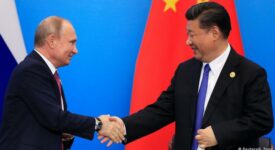The special Shanghai free trade zone that was launched in late September is envisaged to be a full market-based economic zone with minimum governmental intervention and is the first Hong-Kong-like zone in the mainland of China. China’s officials believe that it will become a snapshot of China’s ability to keep up with the cutting-edge world economy. It is also hoped that the zone will tease the world trade rules by helping China to negotiate regional trade agreements around the globe. The first group of measures is targeted primarily on foreign investors. First twenty-five of them have been already granted a permission to set up their businesses – both private and state-owned – within the zone.
The plan for a brand new Shanghai zone was proposed in July and was supported by top government representatives including Prime Minister Li Keqiang, who took office in March. The zone has about eleven square miles and covers four special economic zones in Pudong district. China’s intention was to create a venue of economic experimentation and the implementation of long-awaited reforms. For instance, interest rates will be set by the markets and experiments will be conducted also with the Chinese regulated currency. According to China’s State Council, the renminbi should be freely exchangeable for other currencies. Moreover, eighteen sectors will loosen regulation for foreigners, including China’s heavily-regulated service sector. Unfortunately, Shanghai Free Trade Zone (SFTZ) will not include several wished-for reforms, such as the permission regarding auctioning antiquities, access to uncensored Internet and decrease in corporate tax.
Stefan Sack of the European Chamber of Commerce in China said that “the new zone shows that the new government is keen on making reforms” yet warned that “a free-trade zone in Shanghai alone will not change how business is done in China”. The latter statement, therefore, does not please entrepreneurs complaining about logistic, cultural and red-tape difficulties with doing business in China. Many have expected that Shanghai will follow the success of Shenzhen special economic zone near Hong Kong created more than thirty years ago, yet launching of the new zone on the mainland of China has been a disappointment for many investors worldwide.
Firstly, Beijing has not yet stated precisely how the zone is going to operate and the full report on regulations will be available only next year. This is typical of Chinese business environment, which seems to change in China across time and geography. Therefore, predictable regulations could benefit SFTZ as well as China the most. Second, questions linger in terms of economic and financial policies. More precisely, it is not actually clear whether the Chinese leadership is unanimous in supporting its functioning. Most high-level officials, surprisingly including also the Prime Minister, were missing during the opening ceremony in Shanghai on September 29th.
Generally, the idea of the Chinese economy in terms of foreign investment is such that everything is forbidden unless it is specifically allowed, whereas the SFTZ should have been the exact opposite – everything was supposed to be allowed unless specifically forbidden. Therefore, international firms have also been somewhat shocked by the list of about 1000 business areas that are prohibited for the international investors.
European firms have been slow to react to the new opportunities presented by the Shanghai zone as well. The EU’s FDI activity has been shrinking since the onset of the recession in 2008, prior to which its FDI peaked at more than 2 trillion USD. Currently, observers anticipate a slow improvement – a rebound of about 1.8 trillion USD – between 2012 and 2015. If the prospects signal a thorough economic recovery in the European markets, the SFTZ might prove to be a gate to increase EU’s FDU in China, which currently makes only 2-3% of the total European FDI abroad. Moreover, Shanghai offers an unprecedented possibility to increase investment in the Chinese service market, which up to date accounted for just one tenth of the entire EU investment package in China. EU-China FDI flows show vast potential, but it is now up to both sides to decide how they want to utilize ‘New Shenzhen’ to get the most out of that potential.







